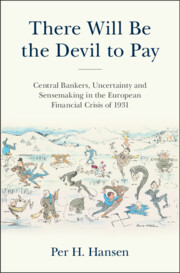 There Will Be the Devil to Pay
There Will Be the Devil to Pay Book contents
- There Will Be the Devil to Pay
- Studies in Macroeconomic History
- There Will Be the Devil to Pay
- Copyright page
- Contents
- Frontispiece
- 1 Introduction
- 2 Central Bankers and Their World
- 3 Preparing for Crisis (May 11–May 19)
- 4 Foreign Creditors (May 16–May 25)
- 5 Moratorium or Guarantee? (May 25–May 27)
- 6 Guarantee at Last? (May 26–June 1)
- 7 Releasing the BIS Credit (May 29–June 5)
- 8 Surrounded with Trouble (June 5–June 10)
- 9 Where and How to Place? (June 8–June 13)
- 10 A World Political Problem (June 11–June 16)
- 11 Francis Rodd Makes Sense – and a Plot (June 9–June 20)
- 12 To Act Now If We Are to Act at All (June 16–June 27)
- 13 Germany Will Collapse (June 19–July 10)
- 14 Anxiety within Germany at Climax (July 11–July 23)
- 15 Going Off the Gold Standard? (July 14–August 21)
- 16 We Must Not Fool Ourselves Now (August 21–September 17)
- 17 As for the Future of England (September 16–October 23)
- The End (2024)
- Timeline
- Actors in the 1931 Financial Crisis Archives
- Acknowledgements
- Archives
- Notes
- Bibliography
- Index
1 - Introduction
Published online by Cambridge University Press: 21 December 2024
- There Will Be the Devil to Pay
- Studies in Macroeconomic History
- There Will Be the Devil to Pay
- Copyright page
- Contents
- Frontispiece
- 1 Introduction
- 2 Central Bankers and Their World
- 3 Preparing for Crisis (May 11–May 19)
- 4 Foreign Creditors (May 16–May 25)
- 5 Moratorium or Guarantee? (May 25–May 27)
- 6 Guarantee at Last? (May 26–June 1)
- 7 Releasing the BIS Credit (May 29–June 5)
- 8 Surrounded with Trouble (June 5–June 10)
- 9 Where and How to Place? (June 8–June 13)
- 10 A World Political Problem (June 11–June 16)
- 11 Francis Rodd Makes Sense – and a Plot (June 9–June 20)
- 12 To Act Now If We Are to Act at All (June 16–June 27)
- 13 Germany Will Collapse (June 19–July 10)
- 14 Anxiety within Germany at Climax (July 11–July 23)
- 15 Going Off the Gold Standard? (July 14–August 21)
- 16 We Must Not Fool Ourselves Now (August 21–September 17)
- 17 As for the Future of England (September 16–October 23)
- The End (2024)
- Timeline
- Actors in the 1931 Financial Crisis Archives
- Acknowledgements
- Archives
- Notes
- Bibliography
- Index
Summary
After a brief introduction to the outbreak of the Austrian Credit Anstalt crisis in May 1931 and the early response by central bankers from Bank of England, the BIS and the New York Federal Reserve Bank, this chapter proceeds to present the book’s overall issues and main concepts, which will be used as a heuristic framework throughout the narrative. The main concepts of the book are radical uncertainty, sensemaking, narrative emplotment, imagined futures and epistemic communities. In the chapter, I discuss how these concepts are helpful in understanding central bankers’, and other actors’, decision-making and practices in the five month from May through September. The chapter also discusses my analytical strategy and presents the empirical material, which comes from the Bank of England, Bank for International Settlements, the Federal Reserve Bank of New York, the J.P. Morgan Archive, the Rothschild Archive and a few others. At the end of the chapter, I present the structure of the book.
Keywords
Information
- Type
- Chapter
- Information
- There Will Be the Devil to PayCentral Bankers, Uncertainty and Sensemaking in the European Financial Crisis of 1931, pp. 1 - 21Publisher: Cambridge University PressPrint publication year: 2025